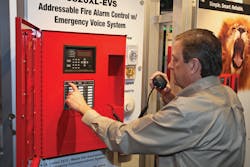Fire & Life Safety: Panel Innovations
Advancements in fire alarm control panels have always seemed to evolve slowly over time. Historically, in many instances, panel changes have been born out of codes and standards changes; however, things like “the cloud” and intuitive touch screens that have permeated our everyday lives have been incorporated into new panel designs.
Loud calls for a reliable means of communicating with people in emergencies following tragedies involving terrorists, active shooters, tornadoes and other non-fire related incidents have led to the marriage of fire alarm and mass notification, fitting the capabilities of both into one box. Likewise, the integration of other former side-car technologies are following suit.
Intuitive Touchscreen Interface
Bank teller machines, airport check-in kiosks, phones, computers and even your car radios now have sleek touch screens, complete with almost idiot-proof menus to guide users to the next, logical step. Following many end-user interviews and onsite observations, manufacturers like Gamewell-FCI have found most end-users not comfortable with the thought of having to “touch” their fire alarm system. The “fear of fire alarm systems” becomes real when horns and strobes are blaring, while facility managers, building owners or security guards are standing at the panel wondering what to do, while fearing the push of one wrong button will summon the fire department, turn-on sprinklers or break the system altogether.
Today, touchscreen interfaces are being incorporated into panels, which feature intuitive menus to help novices navigate their way through the use of a fire alarm system without the fear. While helping them with common operations, such as temporarily disabling devices, silencing an alarm or determining who to notify in an emergency, these intuitive interfaces are making it easier for end users to understand the cause and location of the alarm, along with other information that can be crucial to emergency response.
Dealer feedback on these end-user-friendly systems has been largely positive as well. What dealer wants to answer those common late-night calls to explain how to acknowledge an alarm or silence a system? Most dealers also want to avoid having to send a technician to the site to reset the alarm.
Once thought of as a fancy add-on for larger, high-end systems, these new user-friendly features are moving downstream to more commonly-used addressable panels. As intuitive touchscreen technology becomes more threaded into the lives of Americans, there will soon be an expectation for all fire alarm control panels to offer this type of interface that is both valuable and popular to customers.
Servicing Fire Using the Cloud
People love the idea of “the cloud” because of the easy access to data it offers — particularly to those in the field, on a job site. Imagine the daunting task of testing a fire alarm system — a dealer responsibility that is required by code to take place at least once a year. How can this task be simplified, streamlined and made more cost-effective?
New software tools developed by companies like Honeywell Fire Systems can enable dealers to improve the speed and outcome of walk tests. Using tablets and smartphones to tie into the main fire alarm control panel, a single technician can conduct an entire walk test, replacing the common scenario of one tech testing field devices while another stands at the panel to verify the response. For larger sites, these new software tools can even allow multiple technicians to conduct tests simultaneously.
With technician and end-user signatures able to be captured onsite, required reports can be created immediately, emailed to the customer and then stored in the cloud for 24/7 access by the dealer, end-user and/or Authority Having Jurisdiction (AHJ).
Service contracts are a great source of recurring monthly revenue (RMR) for dealers. Dealers who can automate their contractual responsibilities, such as walk tests, can greatly improve their RMR returns. The same software tools that tie into the panel for testing can also be used to stay on top of upcoming inspections, almost automating the process for dealers while offering immediate access to site histories and maps — all stored securely in the cloud.
All-in-One Boxes
There are many functions that previously were performed as sidecar applications to the fire alarm control panel. Voice evacuation is a good example, where a separate system tied into the fire alarm panel was the only technological means for broadcasting pre-recorded messages or sending live pages. These sidecar systems still exist, but combination fire alarm and voice evacuation panels are becoming more common. Manufacturers like Notifier and Silent Knight offer these combination panels, which include mass notification abilities that meet the requirements prescribed by the National Fire Protection Association (NFPA) and the Department of Defense for emergency communication/mass notification systems.
These emergency communication systems (ECS) expand the fire alarm system to respond to more than just fire events. Companies like Fire-Lite Alarms have even developed a method for allowing authorized individuals to call into the control panel using a cell phone or landline to send live pages.
Unlike their ancestors that comprised big cabinets, heavily laden with hardware, today’s fire alarm control panels are much more software based, with new, more powerful microprocessors inside smaller enclosures. The capabilities of current software is allowing these sophisticated systems to incorporate more common elements, such as touch screens and remote connectivity to data in the cloud. As these software-based systems evolve, the ability to incorporate more functionality and features into the fire alarm control panel will grow as well.
Jeff Netland is Vice President of Engineering for Honeywell Fire Systems.


